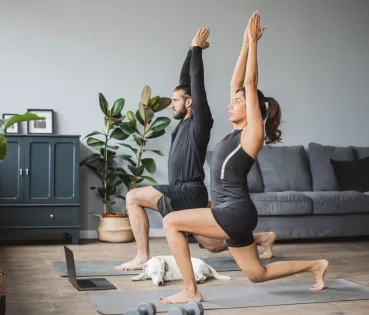
Get active!
Physical exercise decreases the risk of suffering from back pain. Additionally, maintaining as much activity as possible when the pain appears shortens the amount of time it is suffered and reduces the risk of it being repeated. In other words, get moving!
“It is better to do a little sport than nothing at all”, doctors from the Kovacs Back Unit at the Hospital HLA Universitario Moncloa affirm. It is essential to keep your muscles in good condition and able to protect your back. Additionally, “the right exercise, carried out correctly has a positive influence on symptoms such as pain, inflammation and muscle contracture,” they explain. Their advice is listed below.
AEROBIC CARDIOVASCULAR EXERCISE
Just walking 30 minutes or 1 hour a day is very positive for health in general and specifically for your back. “Walking, swimming or using an exercise bicycle or an elliptical exercise machine generate aerobic cardiovascular work that will make your heart pump blood to all the tissues, among them, the ones in your back.”
BE CAREFUL WITH PADDLE TENNIS
Some physical activities, due to their characteristics, can involve a risk for your back. Sports such as squash, tennis, paddle tennis or basketball require a complementary gymnastic effort because, although it is beneficial to play them, at times they generate asymmetries, overloads or sudden efforts that require the muscles to be prepared in order to be able to carry them out without becoming overloaded.
SWIMMING: IS IT AS PERFECT AS PEOPLE SAY?
Swimming is good due to its intrinsic characteristics, but not as much as the myth tells us. If we swim in an unsuitable way or we don’t know how to swim, we can overload our backs and shoulders, without forgetting that there are people who don’t know how to swim, don’t like it or have problems with water. In short, “Swimming is as recommendable as going to the gym or doing exercise routines.”
AT COMPETITION LEVEL
Competitions are not made for body health or for back health. “Scientific studies coincide in showing that back pain is more frequent amongst top level sports men and women in any sport. At this level, the goal does not involve healthy exercise, but rather winning at the expense of taking the body to its limits and this is where the injuries occur. Also, some sports generate muscular asymmetries that require specific exercise to compensate for them.”
3 keys
1. Adapt the physical exercise to your routine according to your possibilities, characteristics, age and illnesses (whether they affect your spine or not). To do this, consult your doctor or other health professionals, such as physiotherapists. But at all ages, any exercise is better than none.
2. Be constant and exercise at least 2 or 3 times a week. Regular exercise is much more effective than doing something now and again or when you think your back is going to hurt.
3. If you feel any pain, stop. Any exercise focused on the spine that causes pain when doing it means that either you are doing it incorrectly or it is not the right time to be doing it.




